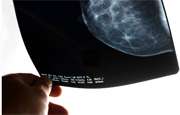Three-dimensional stereoscopic digital mammography significantly improves the specificity and accuracy of breast cancer detection, with a lower patient recall rate and a sensitivity comparable to that of standard digital mammography in a high-risk population, according to research published in the January issue of Radiology.
(HealthDay)—Three-dimensional stereoscopic digital mammography (DM) significantly improves the specificity and accuracy of breast cancer detection, with a lower patient recall rate and a sensitivity comparable to that of standard DM in a high-risk population, according to research published in the January issue of Radiology.
Carl J. D'Orsi, M.D., of the Emory University School of Medicine in Atlanta, and colleagues compared the rate of patient recall and detection of cancer in 1,298 examinations from a cohort of 779 women at high-risk for breast cancer who underwent stereoscopic DM and standard DM. Case truth was determined by the results of one-year follow-up or biopsy.
The researchers found that, for detection of cancer, the specificity (91.2 versus 87.8 percent) and accuracy (90.9 versus 87.4 percent) were significantly higher for stereoscopic DM than standard DM, but the sensitivity was comparable (68.4 versus 63.2 percent). The patient recall rate was statistically significantly lower with stereoscopic DM compared with traditional DM (9.6 versus 12.9 percent).
"In conclusion, we found that DM and stereoscopic DM do not differ significantly in sensitivity for the detection of cancer. However, we did find that stereoscopic DM has significantly higher specificity than does DM," the authors write. "Further study is warranted to determine the efficacy of stereoscopic DM at a total dose equal to that of DM for breast cancer detection and in a general, non-high-risk population."
Several authors disclosed financial ties to the medical device, diagnostic, and imaging industries.
More information:
Abstract
Full Text (subscription or payment may be required)
Journal information: Radiology
Copyright © 2012 HealthDay. All rights reserved.



















